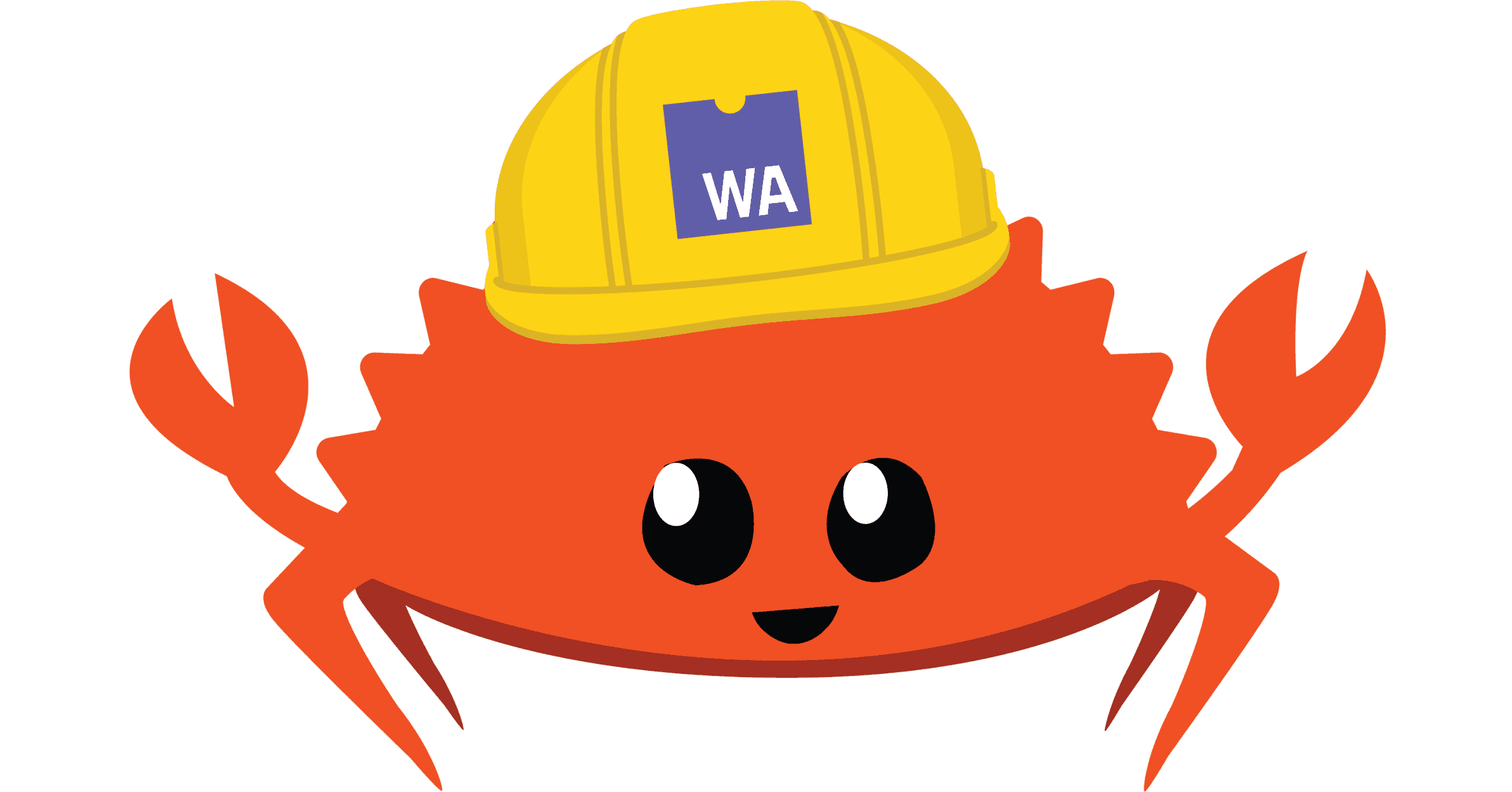
Introduction to WebAssembly and Rust
WebAssembly
Rust
By Bojan Stipic
2022-07-20
33 min read
This article gives an overview of WebAssembly and Rust alongside practical step-by-step examples of how to use them in your next Web app. If you would like to speed up performance-critical parts of your app, port a legacy codebase to the Web, or completely write your frontend in a programming language other than JavaScript, then this blog post is for you!
1. WebAssembly Introduction
WebAssembly (abbreviated Wasm) defines a format for universal architecture independent executables.
It is a completely open standard with an extensive specification. Announced in 2015, and first released in 2017, WebAssembly became a World Wide Web Consortium (W3C) recommendation in 2019.
Wasm is designed to be used as a compilation target. Instead of writing Wasm code by hand, we can write programs as usual, in any programming language we already know and love, and then compile them into Wasm. At the time of writing, there are ~45 languages reported to support Wasm as a compilation target.
Wasm is designed to be portable, compact, and execute at or near native speeds. WebAssembly, as the name suggests, was first meant to be used on the Web, but because of the above characteristics and its open specification, today it can used pretty much anywhere.
Wasm is available on:
-
The Web
Wasm can be executed directly in Web browsers. This will be the main focus of this article, so we will talk about this in great detail in the following sections.
-
Node.js
Wasm can be executed in Node.js, meaning that Node.js is not just a JavaScript runtime anymore, but a runtime for any programming language that can be compiled to Wasm.
-
Embeddable in other programs
Since Wasm is a simple format that is easy to parse, Wasm can be embedded into other programs simply by importing a Wasm runtime in the form of a library.
Because of this, Wasm can be used to implement a plugin system.
Take extensible text editor Vim as an example -- in order to write a plugin in Vim, user is required to use Vimscript, which is a language only used in Vim. This makes writing plugins for Vim not very accessible. On the other hand, there are newer generation editors, such as Neovim that uses Lua for writing plugins, or Atom that is written in web technologies and allows writing plugins in JavaScript; Since these languages have much wider usage, writing plugins for these editors becomes more accessible. But, we can go a step further by allowing plugins to be written in Wasm -- now users can use any programming language that can be compiled to Wasm to write plugins. This makes the barrier to entry very low, and allows for a thriving plugin ecosystem.
-
Kernel
This is currently experimental, but there is an ongoing effort to create a kernel that can execute Wasm binaries directly. This would allow all user space programs to be compiled into Wasm once, and then executed on any computer, independent of the target CPU architecture, as long as the kernel itself supports that architecture.
2. WebAssembly on the Web
All major browsers today can run Wasm natively.
The following are the use cases to use Wasm on the Web:
-
Speed up performance-critical parts of an app
Since Wasm is a simple format that is easy to parse, programs written in Wasm usually give better performance compared to JavaScript.
-
Existing programs can be ported to run on the Web
For example, a legacy desktop app written in C or C++ can be ported to run on the Web with very little effort, by using a compiler that can compile these languages to Wasm.
-
Write frontend apps in any programming language that can compile to Wasm
To do any kind of frontend programming, previously there was no choice -- JavaScript had to be used as that was the only programming language understood by browsers. With the introduction of Wasm on the Web, it is now possible to use any programming language to write frontend apps. If someone does not know JavaScript, or does not want to use it for any reason, they can now choose to use a different programming language they like.
Alright, so now that we know what is WebAssembly and why it is important, let's now switch over to the other main topic of this article -- Rust. After introducing Rust, we will see how these 2 technologies piece together.
3. Why Rust?
Rust is a systems programming language with a focus on performance, reliability and productivity.
The distinction between systems programming and application programming is that the latter aims to produce software which provides services to the user directly, whereas systems programming aims to produce software which provide services to other software. Examples of system programs are operating systems, compilers, Web browsers, etc. Rust was initially developed by Mozilla with the goal of using it to write parts of Firefox browser.
-
Performance
Programs written in Rust are fast and memory efficient, with no runtime. There is no garbage collector, green threads, or anything else that would have a runtime overhead. On one hand, programming in Rust is more complex compared to other higher level languages, but on the other hand it allows us to have complete hardware control and great performance. Everything in programming language design is a trade-off, and since Rust is a systems programming language, it values performance over complexity.
-
Reliability
Rust has a rich type system and ownership model that guarantee memory-safety and thread-safety. These types of bugs are a compile time error in Rust, which means that programs that do compile are guaranteed not to have these issues. This gives confidence that programs written in Rust are highly reliable.
-
Productivity
Productivity here means developer productivity. Developer experience is excellent with Rust. Documentation is great; there is an official Rust book for learning the language, and the standard library is completely documented with runnable examples for most functions. Package manager and build tool is builtin, and the compiler gives very friendly error messages. There is also an LSP server, formatter, documentation generator, test runner, and everything else one might expect from a modern language.
3.1. So What Does Rust Have to Do with WebAssembly?
Rust is great because we don't have to choose between performance, reliability, and productivity -- we can have all three!
Performance and memory efficiency is especially important for Wasm, because Wasm does not provide any runtime out of the box. Any programming language runtime machinery that runs under the hood would also have to be compiled to Wasm and distributed to users. Large codebases not only take a while to download, but they can also cost users' money, because not everyone has an unlimited data plan. On mobile devices it is especially common to have limited data available, so users would not be happy to have their data wasted.
3.2. But Why Not C++?
C++ also gives performance comparable to Rust. Both languages compile to LLVM, which benefit from the same optimizations, making the final code run fast with no overhead.
Unfortunately, reliability is lacking. C++ has no memory-safety and thread-safety guarantees, and these bugs can be especially hard to debug.
According to Microsoft, ~70% of the security vulnerabilities Microsoft assigns a CVE each year continue to be memory safety issues.

Programmers have to be very careful in order to avoid these issues, and there is a huge set of rules which should be checked manually, because the compiler is not able to help. For example, C++ Core Guidelines written by Bjarne Stroustrup (the creator of C++) are ~700 pages long, and most of the rules cannot be checked by the compiler.
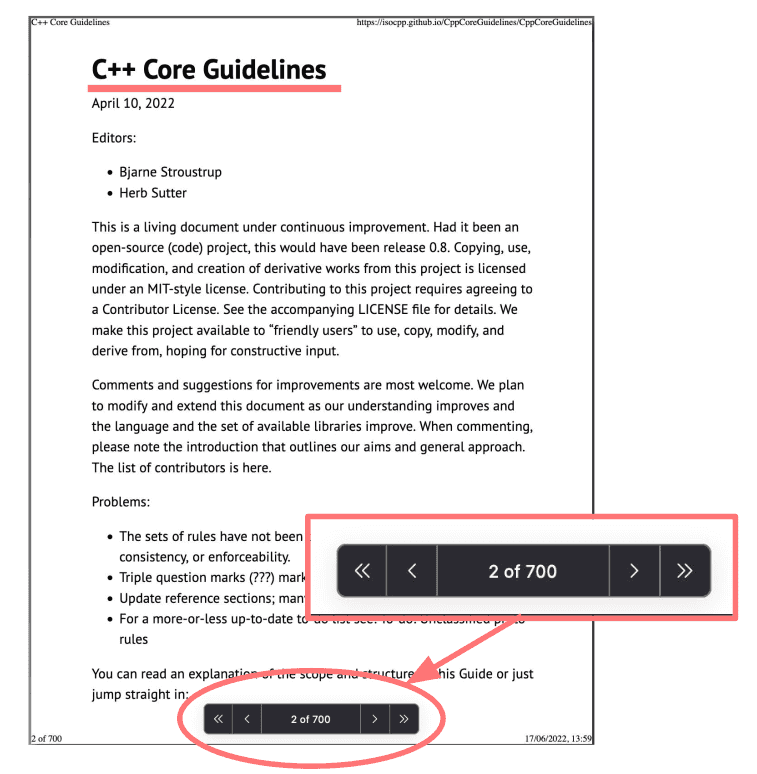
Newer C++ versions introduce new concepts that make it easier to avoid mistakes, but the problem is that they cannot remove old non-idiomatic features, because of backwards compatibility. On the other hand, Rust is a newer language that learned from past mistakes, and borrowed only the good parts of C++. Additionally, Rust has a concept of "editions" which makes it possible to introduce backwards incompatible changes when needed.
Aside from that, developer productivity is also lacking in C++. Tooling is not great -- there is no standard package manager, or code formatter, and compiler messages can be unreadable when templates are involved.
3.3. But Why Not Python?
Python, on the other hand provides good developer productivity. It is very easy to write a quick Python script and get it working in no time.
Unfortunately, performance is not great.

This is especially important for WebAssembly, because the whole Python runtime machinery has to also be compiled to Wasm. To put things into perspective, a simple "hello world" program written in Python produces ~10MB Wasm module, but a simple "hello world" program written in Rust takes only ~2-3KB.
Regarding reliability, Python obviously does not have memory-safety issues, because it has a garbage collector, so we don't have to worry about manual memory management, but there can still be thread-safety issues and because it does not have a statically checked type system, programs written in Python do not give much confidence in terms of reliability.
4. A Quick Introduction to Rust
Now that I explained the reasons why I think Rust is a great language and a good fit for WebAssembly, in this section I will give a quick introduction to Rust.
For the purposes of this article, we will focus only on 1 feature that is unique to Rust -- ownership and borrowing.
But first, let's see the obligatory "hello world" example:
Rust has a C-like syntax. Functions are defined using the fn keyword.
Function named main is special -- it is the first code that runs in every
executable Rust program.
In the example above, all that main function does is call the println macro.
We can tell that println is a macro and not a normal function because it
was entered as println! (with the !).
Macros are out of scope of this article, but for know you just need to know that
using a ! means that you are calling a macro instead of a normal function,
and that macros don't always follow the same rules as functions.
4.1. Ownership Rules
Now to the interesting part. Ownership and borrowing is Rust's most unique feature and has deep implications for the rest of the language. It enables Rust to make memory safety guarantees without needing a garbage collector.
Ownership rules:
- Each value in Rust has a variable that's called its owner.
- There can only be one owner at a time.
- When the owner goes out of scope, the value will be dropped.
The following is an example that demonstrates ownership rules:
First, the string value "world" is created and assigned to the variable s.
The variable s is called the owner of that string value.
Now that s is the owner of the string "world", there cannot be any other
variable that is also the owner of that same string value.
When s goes out of scope (at the end of the main function),
it releases all resources that were allocated for the owned value.
This way, there is no need for garbage collector.
If it was possible to create multiple owners to a single value, it would not be clear which owner would be responsible to release resources. If they would both try to release same resources, that would be one of the memory safety bugs -- double free bug.
The most important thing is that all of the rules above are enforced by the compiler, and if any of these rules are violated, the program will not compile.
In other languages without garbage collector, for example C++, in order to create a program without memory-safety bugs, we would still have to follow all of the rules above. The difference is that these rules are not enforced by C++ compiler, so we could easily make a mistake and create a bug that is very hard to debug.
4.2. Move Semantics
Now that we have seen ownership rules, and now that we know that a value can only have a single owner, the question is what would happen if we tried to assign a value from 1 variable to another:
A JavaScript programmer would probably say that after s1 is assigned to s2,
they are just references that now both point to the same string.
This would be okay in a language with garbage collector, but it would be very
wrong to have 2 owners in Rust, as explained in the previous section.
On the other hand, a C++ programmer would probably say that s2 = s1 does a
deep copy, so now s1 and s2 would be owners of 2 completely unrelated strings.
This would solve the 2 owners problem, but the problem is that deep copy
can be a very expensive operation, depending on how large the value is.
Rust decided to do a different thing -- assignment has move semantics by default.
When we write s2 = s1 we state that s1 is moved to s2.
In other words, s1 gives ownership of string "hello" to s2.
After giving ownership, s1 is no longer valid and compiler forbids using s1
afterwards.
In the example above, trying to access s1 in println would give a compile time error:
To better understand what moving means, let's see what happens under the hood:
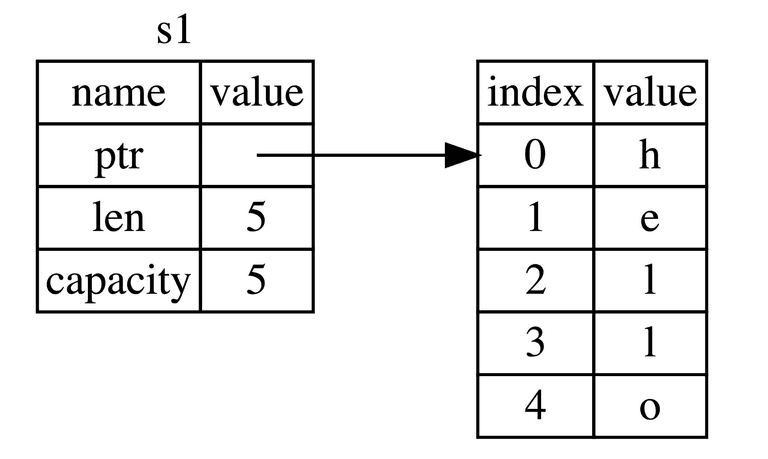
s1 is stored on stack and contains a pointer to the heap allocated string,
a length, and a capacity.
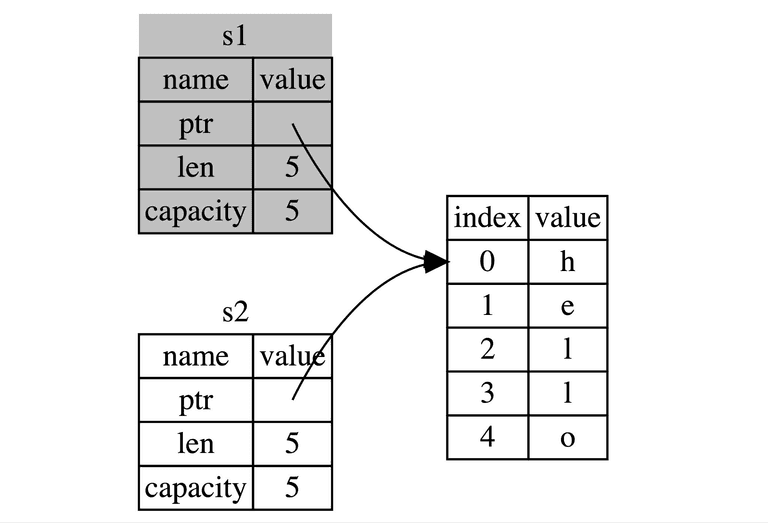
Moving s1 to s2 will just copy the value on the stack.
Now s1 and s2 both point to the same heap allocated string.
That would normally be a problem, because there shouldn't exist 2 owners
of the same value, but Rust compiler is aware of move semantics, and will mark
s1 as invalid and will not allow us to use it afterwards.
This way, we avoided a potentially expensive deep copy, but still managed
to preserve the only one owner rule.
Note for C++ developers:
Move semantics exist in C++ and originated in C++11. Rust actually borrowed this concept from C++.
Problem is that C++ does deep copy by default.
If we wanted to do a move instead, we would have to write s2 = std::move(s1).
This is the opposite of what Rust does.
Rust makes potentially expensive operations always explicit,
so if we wanted to do a deep copy we would have to request that explicitly by
writing s2 = s1.clone().
Being explicit is better because that means that the programmer didn't opt-in
to do an expensive operation by accident, but that they are aware of it and
decided to do it after careful consideration on a case by case basis.
Another problem is that C++ compiler does not prevent us from using s1 after move.
We could try to use s1 after moving, and the program would compile,
but accessing s1 would be undefined behavior that would be very hard to debug.
4.3. Function arguments are also moved
An interesting thing to point out is that values passed as function arguments are also moved:
Here we have calculate_length function, which takes a string as parameter.
As the name implies, the purpose of this function is to calculate the length
of given string.
In main function, we create s1 and pass it to calculate_length function.
Ownership of s1 is now moved to s.
Since s is local to calculate_length function, it will go out of scope at the end
of the function, and it will deallocate the value "hello".
If we then try to print s1, we will rightfully get a compile time error:
If we were to write an equivalent C++ program, this would compile, but would be an undefined behavior which would be very hard to debug. Fortunately, Rust compiler saved us once again, and prevented us from making the mistake.
Now, this is all great, but it would be very tiresome to program in Rust if all functions would just "eat" all of their arguments. If a function should just calculate the length of a given string, there is no need for it to take ownership and deallocate that string. Luckily, there is a solution to this problem -- Rust has a feature for using a value without transferring ownership, called references.
4.4. References and Borrowing
Instead of giving ownership of a value, it is possible to just borrow a value for some time, and then return it back later. Borrowing values produces references.
To borrow a value, instead of transferring ownership, we just have to add &
in front of a variable.
r1 is now a reference to the string "hello".
The ownership rules are not violated, because we still have only 1 owner,
we are just borrowing the value temporarily.
In the example above, r1 is an immutable reference.
This means that we can read the value by accessing r1,
but we are not allowed to change the string in any way or deallocate it.
Similar to immutable references, it is also possible to create a mutable reference:
Instead of &, we have to use &mut to create a mutable reference.
In this case, r1 can read the string and modify it,
but it is still not able to deallocate it.
Only the owner is able to drop the string.
Like ownership rules, references also have some rules that Rust compiler enforces.
References and borrowing rules:
- At any given time, you can have either one mutable reference or any number of immutable references.
- References must always be valid.
First rule is interesting because that means that Rust allows mutation only in a very controlled manner. The benefit of having this restriction is that Rust can prevent data races at compile time. For data race to happen, 2 or more threads must have access to a shared resource, where at least 1 thread has write access. Data races cause undefined behavior and can be difficult to diagnose and fix. Rust prevents this problem by refusing to compile code with data races.
The second rule states that references must always be valid. To explain what "being valid" means, it is best to look at some examples:
- Variable
r1is created, but not initialized immediately. - A new block is opened, in order to create a new scope.
- In the inner scope, a new string is created and assigned to the owner
s. sis borrowed and the reference is assigned tor1.- The inner block goes out of scope, so all of the owners that were declared inside of that scope deallocate their values.
- We try to read the string by accessing
r1.
r1 is a reference to a string that has been deallocated, and trying to access it
would be a bug.
If we were to try to do the same thing in C++, this code would compile, but would be an undefined behavior, which would be very hard to find and fix.
Thankfully, Rust compiler jumps in to the rescue once again. The compiler is able to understand that references cannot outlive the owner, and prevents us from compiling the program.
What is especially nice is that compiler gives a very user friendly message, and explains exactly what the problem is and how to solve it.
Let's look at another example:
- A local variable
sis created, and is the owner of string"hello". - We try to borrow
sand return the reference from the function.
Again, an equivalent program in C++ would compile, but this is also an
undefined behavior.
Since s is local to this function, it would get out of scope at the end of the
function, and would drop the string "hello".
So, the returned reference would point to string that does not exist.
Trying to access that string via this reference would cause an undefined behavior.
Rust knows that a reference cannot outlive the owner, and refuses to compile this program.
4.5. Function arguments passed by reference
Now that we have learned about references and borrowing, we can return back to
one of the previous examples where we saw calculate_length function.
The function was calculating the length of a string that was passed in as a parameter,
but it was also taking ownership of that string, so it would "eat" the value.
To solve the problem, we just have to change calculate_length
to take a reference to string instead:
When the calculate_length is called, we no longer give ownership of s1,
but borrow it instead.
After the function returns, we can continue using s1 normally.
5. Compiling Rust to WebAssembly
Alright, if you are still reading this, you have come to the fun part. We are going to compile a Rust program to WebAssembly and run it in our browser.
Prerequisites:
-
Install the Rust toolchain
-
Install wasm-pack
We are going to need wasm-pack in order to compile programs to Wasm. We can install it using
cargo-- the Rust's package manager:$ cargo install wasm-pack -
Create a new package:
We can also use
cargoto initialize a new package:$ cargo new --lib hello-wasmThis creates a new library in directory named
hello-wasmand initializes the following file structure:+-- Cargo.toml+-- src+-- lib.rsCargo.tomlis analogous topackage.json-- here we can specify some metadata about our package, and also declare dependencies.In
srcdirectory,lib.rsfile was created, which is the root source file. We are going to put all of our source code there. -
Write a simple program:
use wasm_bindgen::prelude::*;#[wasm_bindgen]pub fn factorial(n: u32) -> u32 {(1..=n).product()}factorialis just a normal Rust function. The function is prefixed withpubwhich means that it has public visibility and is available outside of the library. The only unusual thing we have to do to make it compile to Wasm is to add thewasm_bindgenattribute. We will talk more about wasm-bindgen in later chapters, but for now we just have to know that it will generate some JavaScript glue code for us that is required in order to be able to usefactorialfrom the browser.I intentionally chose to show
factorialfunction, so that we can see how Rut provides some nice abstractions that makes it possible to write concise and easy to read code.(1..=n)construct creates an inclusive range of unsigned integers from1ton. Ranges are iterable so we can use on them any method available inIteratortrait. One such method isproductwhich iterates over the entire iterator, multiplying all of the elements. You can think of it like a specializedreducefunction.What is especially nice and important to note is that all Rust's abstractions are "zero cost" abstractions. This means that these abstractions do not have any runtime cost. Using these abstractions produces code that has exact same runtime performance as an equivalent hand written code.
-
Configure the
Cargo.tomlfile:Inside of
Cargo.tomlfile we just need to addwasm-bindgenas a dependency:[package]name = "hello-wasm"version = "0.1.0"license = "GPL-3.0-or-later"edition = "2021"[lib]crate-type = ["cdylib"][dependencies]wasm-bindgen = "0.2.80" -
Build the project:
Now that we have our simple Rust program, we can compile it to Wasm:
$ wasm-pack build --target webThis does a number of things in the background:
- Compiles Rust code to WebAssembly.
- Runs wasm-bindgen on that WebAssembly, generating a JavaScript file that wraps up that WebAssembly file into a module the browser can understand. We are going to see this JavaScript glue code in more details in the following sections.
- Creates a
pkgdirectory and moves that JavaScript file and our WebAssembly code into it. - Reads
Cargo.tomland produces an equivalentpackage.json. - Copies
README.mdinto the package. - Generates Typescript type definitions in
.d.tsfile.
What we get in
pkgdirectory as a result is ready to be published to npm. After our library is published to npm, anyone can import it and use it like any other regular JavaScript library. They can get all of the performance benefits of using Wasm, but without even having to be aware that we were using Wasm in the first place.For the purposes of this article, we are not going to publish this package to npm, but instead we are going to import it and use it directly from an
index.htmlpage. -
Use the built package:
<!DOCTYPE html><html><body><script type="module">import init, {factorial} from "./pkg/hello_wasm.js";init().then(() => {console.log(factorial(10));});</script></body></html>We can import
factorialand use it like a normal JS function. The only thing different is that we first have to importinitfunction and call it once in order to initialize Wasm module. In the future, it will be possible forscriptelement to import Wasm module directly, but for now we have to have some JavaScript code in order to initialize it.
6. Function Arguments and Return Values
In this section we are going to talk about that JS glue code in more details.
For a given Rust program:
wasm-bindgen generates the following JS glue code:
The generated code does not do a whole lot.
It just creates a wrapper JS function named factorial, which internally
calls factorial from Wasm module, and then returns the result.
Wasm currently only supports functions that deal with number types,
and since factorial only dealt with numbers, the generated JS glue code was
trivial.
If our function accepted some other type as an argument, for example a string, the generated code would be more complicated.
Passing a JS string to a Wasm function:
Since Wasm doesn't have support for strings out of the box, wasm-bindgen has to do some magic for us behind the scenes. To understand what it does, we first have understand how memory works in Wasm modules.
Browser API provides WebAssembly.Memory which is passed to Wasm module
upon initialization.
WebAssembly.Memory is a wrapper around fixed-length raw binary data buffer ArrayBuffer.
That array buffer represent the entire heap of a compiled Rust application.
It can be accessed from Rust, but it can also be accessed from JS,
so it can be used as a shared resource.

So, when we want to pass a string from JS to Wasm, we can write that string somewhere
in that WebAssembly.Memory, and then instead of passing a string to Wasm function directly,
we can pass a pointer and a length of that string.
Since pointer and a length are just numbers, this way we managed to indirectly pass a string
to a Wasm function.

Generated JS glue code for the length function above:
In the snippet above we can see that the generated code first calls passStringToWasm0
helper function, which does exactly that -- it copies the JS string to the Wasm heap,
and then returns a pointer ptr0 and a length len0.
These 2 values are then passed to the Wasm length function.
Not only can we pass the strings to functions, we can pass any object/struct and wasm-bindgen will do the magic for us in a similar way.
7. Interacting with JavaScript and the DOM
In this section we are going to see how to interact with browser APIs from Wasm.
Using JS alert function:
In order to use a JS function in Rust, we have to declare it inside of an extern block.
This is required because Rust is a statically typed language, and it would refuse
to compile the code if we tried to use alert function without specifying what
it is and where it came from.
By specifying function declaration inside of an extern block, we are telling
the compiler that a function named alert exists somewhere outside of this library,
and that it takes a single argument of type string.
wasm-bindgen will make sure to provide this function to the Wasm module upon initialization, and that's it! That is all we had to do!

Similarly, we could import any other function from the Web API.
The only thing we have to do is provide a correct declaration inside of an extern block.
The only downside is that we have to type all of those declarations manually, which is a lot of boilerplate code, and it is also possible to write a wrong declaration and the Rust compiler won't be able to tell us that there is an error because it is not aware of the Web API.
Now, we can do better than this, and use
js-sys and
web-sys crates instead.
These creates are actually nothing special, but just provide these extern blocks
already typed for us.
We can just import whatever we need and start using it.
Example of DOM interaction using web-sys crate:
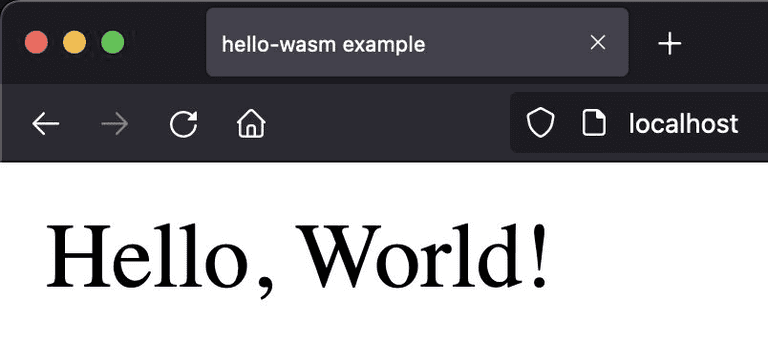
8. Rust Framework for Frontend Web Apps
In previous sections, we have seen how we can create apps that are a mix of Wasm and JS modules. We can go a step further and completely write a frontend web app only in Rust, using Yew framework.
Yew is a compontent-based framework which makes it easy to create interactive UIs. Developers who have experience with frameworks like React and Elm should feel quite at home when using Yew.
As an introduction to Yew, we are going write a simple app -- there will be a
+1 button and a counter initialized to 0.
Every time user clicks the +1 button, the counter will be incremented by 1.
Here is how to finished app will look like:
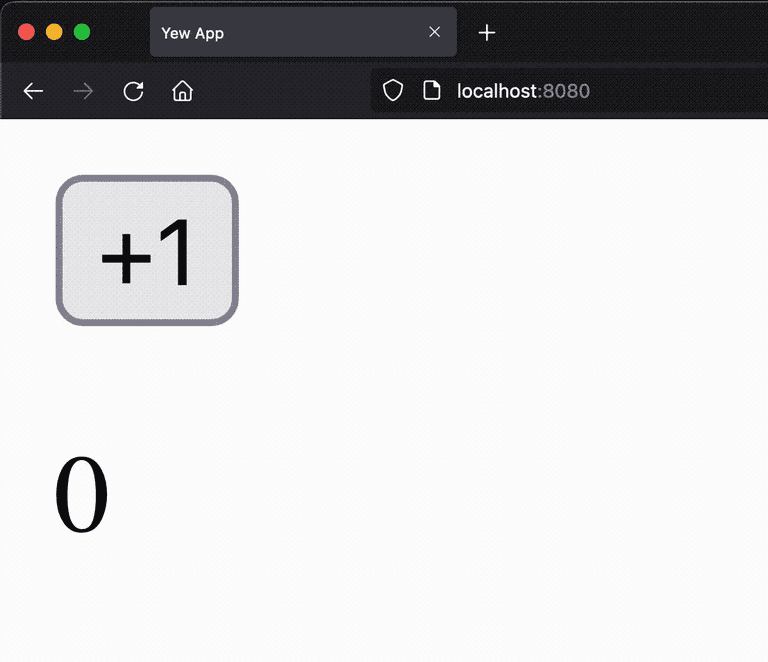
This is how it's implemented:
-
Define messages and component state:
enum Msg {AddOne,}struct Model {value: i64,}Modelstruct represents a Yew component. Fields of this struct represent component state. In this example, state isvalueof typei64(64 bit integer).Msgenum declares all events that can occur inside of a component, such as user clicking a button, completing a form, etc. In this example, there is only 1 event --AddOne, which is triggered when user clicks the+1button. -
Implement
Componenttrait (interface) for theModelstruct:impl Component for Model {type Message = Msg;type Properties = ();fn create(_ctx: &Context<Self>) -> Self {Self { value: 0 }}fn update(&mut self, _ctx: &Context<Self>, msg: Self::Message) -> bool {match msg {Msg::AddOne => {self.value += 1;true}}}fn view(&self, ctx: &Context<Self>) -> Html {let link = ctx.link();html! {<div><button onclick={link.callback(|_| Msg::AddOne)}>{ "+1" }</button><p>{ self.value }</p></div>}}}The most important methods of
Componenttrait arecreate,updateandview.createmethod -- used as a constructor, to initialize component's state. In this example, we are initializingvalueto0.viewmethod -- used to define the UI of the component. Yew provideshtml!macro which enables us to define the UI using a special syntax, in similar fashion to JSX. To display a state value, we use the curly braces and access the value throughself. When the button is clicked, a callback function is called, which returnsAddOnemessage from ourMsgenum we created earlier.updatemethod -- handles events and updates the component state. Update method receives the event as amsgparameter. We can then match on that enum and handle different events. In case ofAddOneevent, we just increment the statevalueby1. After the state is updated, we returntruefrom theupdatefunction -- this tells Yew that the state has change and that it should trigger a rerender. Yew will then call theviewmethod again and display the updated value.
And that is it, we just made our first Yew app!
Yew also has many more exciting features, such as:
- Function components
- Context API
- Router
- CSS-in-Rust
These features are out of scope of this article, but if you are interested to learn more, I suggest heading to their official website and checking out their awesome documentation.
9. Made with WebAssembly
In this section we are going to see some existing projects that are using Wasm, to serve as an inspiration for what is possible to achieve.
Some popular companies using Wasm:
NOTE: The following list contains proprietary software. I do not in any way endorse such software, and I encourage you to always use free software when possible. The purpose of this list is just to highlight some real world use cases for using Wasm.

- Figma -- vector graphics editor and prototyping tool. They claim that WebAssembly cut Figma's load time by 3x.
- Unity -- cross platform game engine. It supports exporting games to the Web using Wasm.
- 1Password -- password manager. They claim that they were able to achieve up to 39x performance increase by switching to Wasm.
- AutoCAD -- computer-aided design and drafting software. Legacy C/C++ codebase was ported to the Web using C++ to Wasm compiler emscripten.
- Google Earth -- 3D representation of Earth based on satellite imagery. Pieces of the old C/C++ application code were ported to the Web using emscripten.
- Disney+ -- streaming service. Client app written in Rust and compiled to Wasm.
- Amazon Prime Video -- streaming service. Parts of app were written in Rust and compiled to Wasm for improved performance.
Some interesting free software projects using Wasm:
-
uBlock Origin -- content blocker by Raymond Hill under GPLv3 license.
Performance sensitive parts were written in Wasm. For example, hostname-lookup algorithm implemented in Wasm was 1.5x faster than the equivalent algorithm implemented in JS when benchmarked on my laptop:
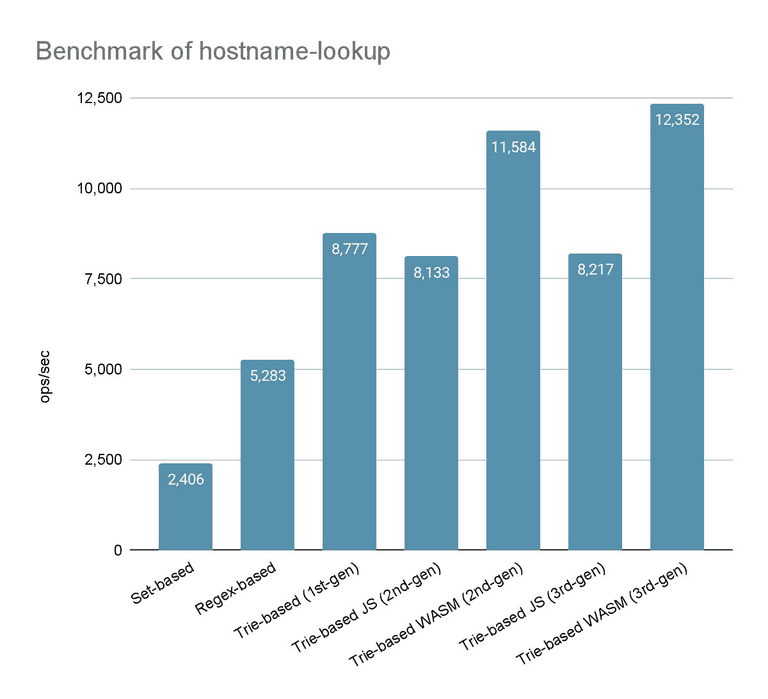
-
ffmpeg.wasm -- FFmpeg for browser and node, powered by Wasm. Created by Jerome Wu under Expat license.
FFmpeg is a tool for audio/video transcoding. In my current company, we had a backend service that did some audio transcoding using FFmpeg in order to convert user submitted files into a desired audio format. With FFmpeg being ported to Wasm, we could've moved that transcoding logic to the frontend, achieving infinite scalability of that service, without costing us anything -- every user would do their own transcoding in their own browser, and just send us the file in the desired format.

-
vim.wasm -- Vim ported to Wasm. Created by https://github.com/rhysd under Vim license.
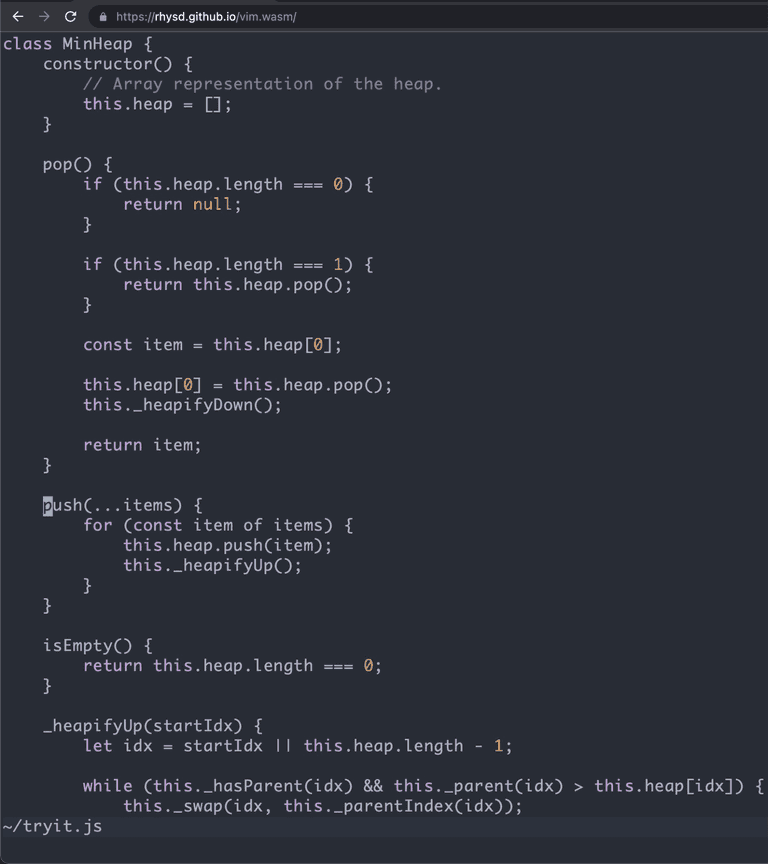
-
D3wasm -- Doom 3 ported to Wasm and WebGL. Created by Gabriel Cuvillier under GPLv3 license.

-
Ruffle -- Flash Player emulator built in the Rust programming language. Created by Ruffle LLC under either Apache 2.0 or Expat license.

-
Wasmboy -- Game Boy/Game Boy Color Emulator Library written for Wasm. Created by Aaron Turner under Apache 2.0 license.

-
v86 -- x86 virtualization in your browser, recompiling x86 to Wasm on the fly. Created by Fabian Hemmer under BSD 2-Clause "Simplified" License.
This project is crazy. I was able to run Arch Linux, start Fluxbox inside of an Xorg session, and run Firefox, and all of that happened inside of my browser!
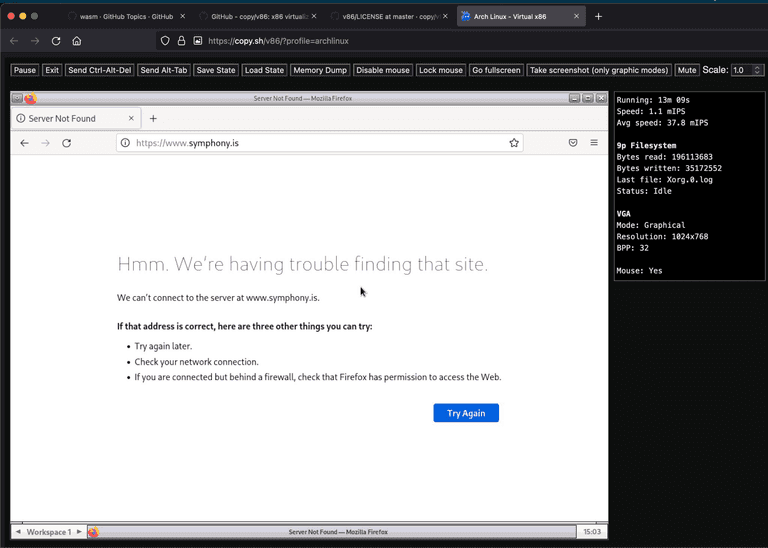
10. The Future of WebAssembly
Wasm is a relatively new standard. It was initially released as a minimal viable product, with the intention of extending and improving it incrementally. Many new features are being worked on, but the most important one in my opinion is WASI -- WebAssembly System Interface.
WASI is a specification for the universal API and ABI that all Wasm runtimes should support. You can think of it as a standard library for Wasm, that will provide access to several operating-system-like features, including files and filesystems, sockets, clocks, random numbers, etc.
Wasm is meant to be portable, but if we interact with Web APIs and JS, we are making our programs tied to the Web browser. With the introduction of WASI, we will be able to make Wasm code truly portable across all Wasm runtimes!
And to finish off this article, I will leave a tweet by Solomon Hykes, the creator of Docker. He sums up really well how important WASI and Wasm are:
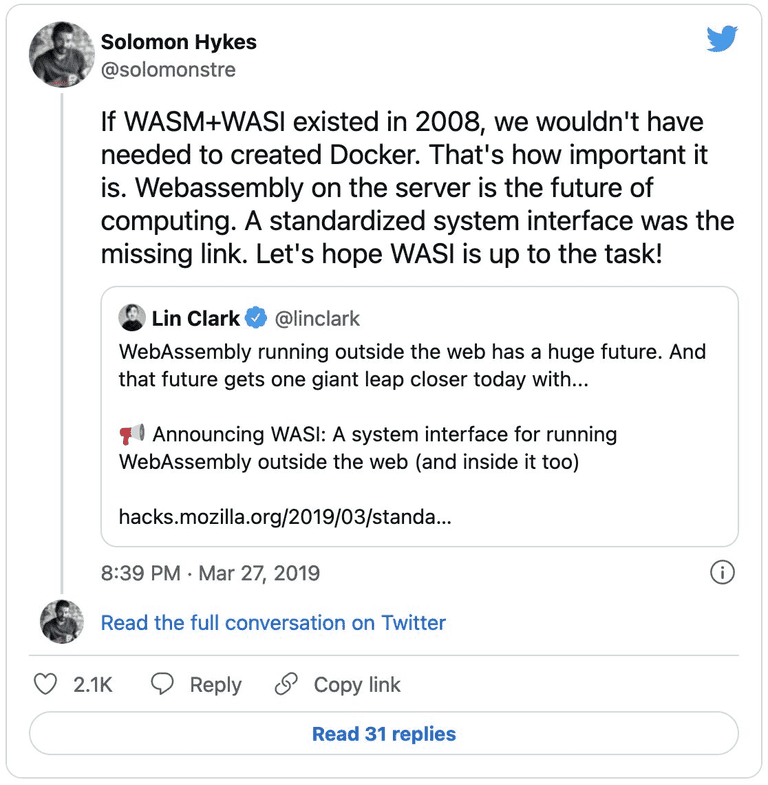
11. Reference
- https://developer.mozilla.org/en-US/docs/WebAssembly
- https://rustwasm.github.io/docs/book/
- https://rustwasm.github.io/docs/wasm-bindgen/
- https://rustwasm.github.io/docs/wasm-pack/
- https://www.novatec-gmbh.de/en/blog/look-ma-no-js-compiling-rust-to-webassembly/
- https://harshal.sheth.io/2022/01/31/webassembly.html
- https://hacks.mozilla.org/2017/07/memory-in-webassembly-and-why-its-safer-than-you-think/
- https://yew.rs/
- https://wiki.osdev.org/WebAssembly
- https://madewithwebassembly.com/
- https://www.rust-lang.org/learn
Cover image by Ashley Williams and rustwasm Working Group.

This work is licensed under a Creative Commons Attribution-ShareAlike 4.0 International License.
Do you have a problem, want to share feedback, or discuss further ideas? Feel free to leave a comment here! This comment thread directly maps to a discussion on GitHub, so you can also comment there if you prefer.